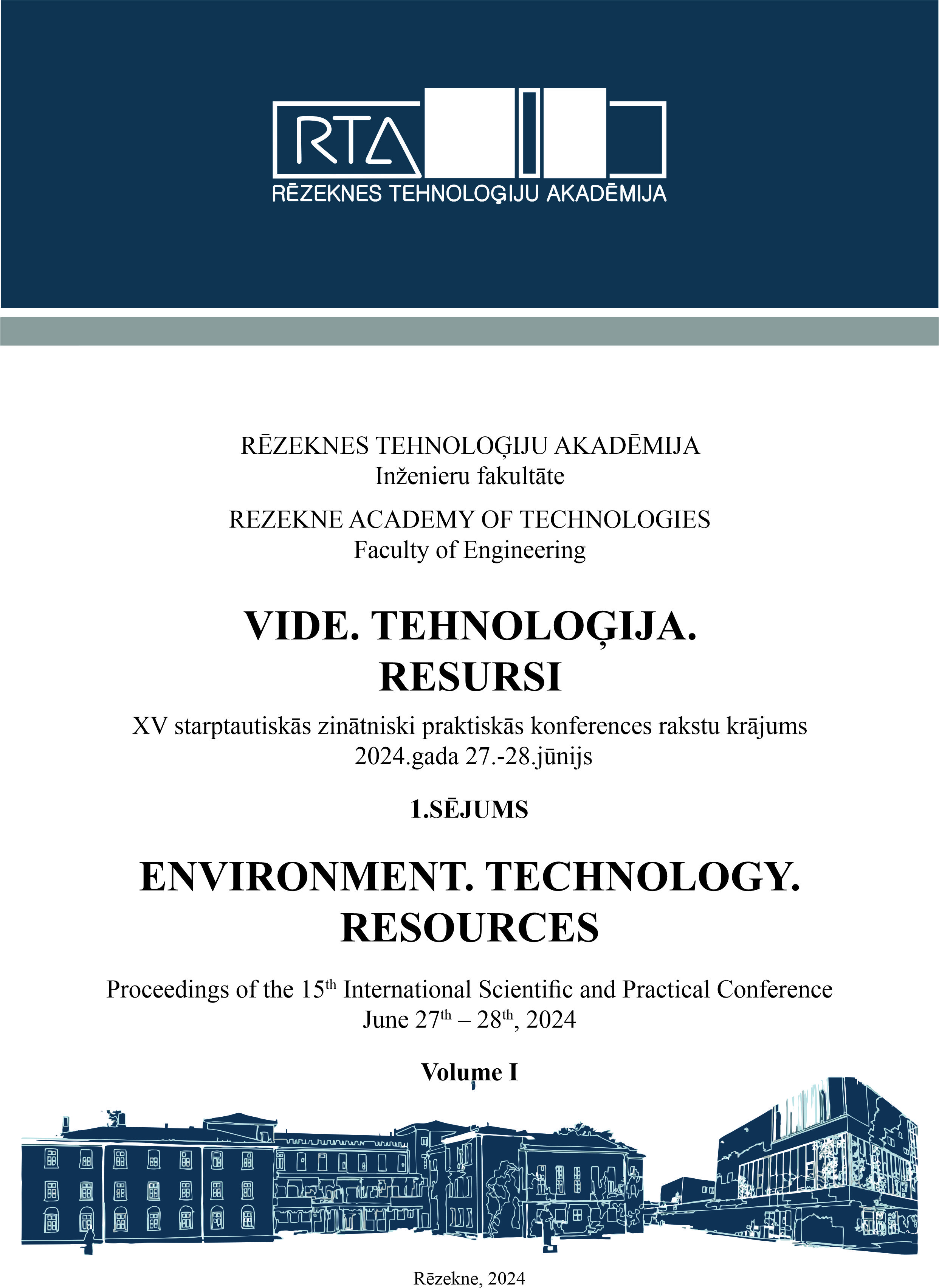DISTRIBUTION OF IRON IN DUST NEAR STREETS: CASE STUDY JELGAVA CITY
DOI:
https://doi.org/10.17770/etr2024vol1.7969Keywords:
Snow, iron, pollution, ICP-OES spectrometer, Kruskal-Wallis testAbstract
The world's urban population is projected to grow to 68% by 2050. According to statistics, 68% of the country's population already lives in Latvia in 2022. Much of the air pollution research in the city is focused on researching highways and streets of very intensive traffic. Small and medium-sized cities with their infrastructure remain unexplored. The population of cities of different sizes is growing every year, so it is important to understand the prevalence of pollution along the streets in small and medium-sized cities, as this pollution has a direct impact on the health of the city population. Snow and stored dust are good matrices to assess the extent of air pollution and metals in urban areas. It should also be stressed that the number of cars in cities is increasing, while the age of the car fleet remains increasing. The aim of the study is to find out how iron is distributed at different distances from the street section in Jelgava city research facilities. Snow samples were collected at 3 monitoring points with a distance of 1 m, 50 m, and 100 m to each side of the street. Snow samples were melted, acidified, filtered, and measured with ICP-OES spectrometer. For data analysis, descriptive statistics, the Kruskal-Wallis test, and the Steel-Dwass-Critchlow-Fligner procedure were used. In all monitoring points, iron pollution in air at 1 m is statistically significantly higher than at 50 m and 100 m (p-value 0.018; and 0.011), which directly indicates the impact of cars on air quality close to the streets. At the monitoring point located on Riga Street, the iron concentration at 1 m distance is 10.9 mg/l and at 100 m 0.33 mg/l. The data obtained can be used when designing streets and conducting urban planning.
Downloads
References
Kang, S., Hwang, H., Park, Y., Kim, H., & Ro, C. (2008). Chemical compositions of subway particles in seoul, korea determined by a quantitative single particle analysis. Environmental Science &Amp; Technology, 42(24), 9051-9057. https://doi.org/10.1021/es802267b
Karlsson, H., Nilsson, L., & Möller, L. (2004). Subway particles are more genotoxic than street particles and induce oxidative stress in cultured human lung cells. Chemical Research in Toxicology, 18(1), 19-23. https://doi.org/10.1021/tx049723c
Baldacchini, C., Castanheiro, A., Maghakyan, N., Sgrigna, G., Verhelst, J., Alonso, R., … & Samson, R. (2017). How does the amount and composition of pm deposited on platanus acerifolia leaves change across different cities in europe?. Environmental Science &Amp; Technology, 51(3), 1147-1156. https://doi.org/10.1021/acs.est.6b04052
Park, J., Han, K. T., Eu, K., Kim, J., Chung, K. H., Park, B., … & Cho, M. (2005). Diffusion flame-derived fine particulate matters doped with iron caused genotoxicity in b6c3f1 mice. Toxicology and Industrial Health, 21(1-2), 57-65. https://doi.org/10.1191/0748233705th215oa
Williams, L. and Zosky, G. R. (2019). The inflammatory effect of iron oxide and silica particles on lung epithelial cells. Lung, 197(2), 199-207. https://doi.org/10.1007/s00408-019-00200-z
Beck‐Speier, I., Kreyling, W. G., Maier, K., Dayal, N., Schladweiler, M. C., Mayer, P., … & Kodavanti, U. P. (2009). Soluble iron modulates iron oxide particle-induced inflammatory responses via prostaglandin e2 synthesis: in vitro and in vivo studies. Particle and Fibre Toxicology, 6(1). https://doi.org/10.1186/1743-8977-6-34
Stankevica, M., Grinfelde, I., Bakute, A., Pilecka-Ulcugaceva, J., Purmalis, O., HEAVY METALS AIR POLLUTION IN JELGAVA CITY LATVIA, International Multidisciplinary Scientific GeoConference Surveying Geology and Mining Ecology Management, SGEM, vol. 21/issue 4.2, pp 75–84, 2021.
Pilecka, J., Grinfelde, I., Purmalis, O., & Burlakovs, J. (2020). Car transport intensity impact on heavy metal distribution in urban environment. IOP Conference Series: Earth and Environmental Science, 578(1). https://doi.org/10.1088/1755-1315/578/1/012032
Grinfelde, I., Pilecka-Ulcugaceva, J., Bertins, M., Viksna, A., Rudovica, V., Liepa, S., & Burlakovs, J. (2021). Dataset of trace elements concentrations in snow samples collected in Jelgava City (Latvia) in December 2020. Data in Brief, 38. https://doi.org/10.1016/j.dib.2021.107300 .
H. B. Mann, D. R. Whitney. "On a Test of Whether one of Two Random Variables is Stochastically Larger than the Other." The Annals of Mathematical Statistics, 18(1) 50-60 March, 1947. https://doi.org/10.1214/aoms/1177730491
Kruskal; Wallis (1952). "Use of ranks in one-criterion variance analysis". Journal of the American Statistical Association. 47 (260): 583–621. https://doi:10.1080/01621459.1952.10483441 .
John D. Spurrier spurrier@stat.sc.edu (2006) Additional Tables for Steel–Dwass–Critchlow–Fligner Distribution-Free Multiple Comparisons of Three Treatments, Communications in Statistics - Simulation and Computation, 35:2, 441-446, DOI: 10.1080/03610910600591834
Pilecka-Ulcugaceva, J., Zabelins, V., Grinfelde, I., Liepa, S., & Purmalis, O. (2021). DISTRIBUTION AND POLLUTION OF CHEMICAL ELEMENTS IN JELGAVA URBAN ENVIRONMENT. International Multidisciplinary Scientific GeoConference Surveying Geology and Mining Ecology Management, SGEM, 21(4.1), 261–268. https://doi.org/10.5593/sgem2021/4.1/s19.43 .
Skorbiłowicz M., Trybułowski Ł., Skorbiłowicz E., Spatial Distribution and Pollution Level of Heavy Metals in Street Dust of the City of Suwałki (Poland), International Journal of Environmental Research and Public Health, 4687, 2023. https://doi.org/10.3390/ijerph20064687 .
Panko, J.M.; Chu, J.; Kreider, M.L.; Unice, K.M. Measurement of airborne concentrations of tire and road wear particles in urban and rural areas of France, Japan, and the United States. Atmos. Environ. 2013, 72, 192–199.
Sugier, P. and Sugier, D. (2018). Impact of road transport on soil physicochemical characteristics and heavy metal concentrations in the bark of purple willow (salix purpurea l.). Acta Agrobotanica, 71(4). https://doi.org/10.5586/aa.1753
Modrzewska, B. and Wyszkowski, M. (2014). Trace metals content in soils along the state road 51 (northeastern poland). Environmental Monitoring and Assessment, 186(4), 2589-2597. https://doi.org/10.1007/s10661-013-3562-z .
Downloads
Published
Issue
Section
License
Copyright (c) 2024 Jovita Pilecka-Ulcugaceva, Oskars Purmalis, Anda Bakute, Sindija Liepa, Inga Grinfelde

This work is licensed under a Creative Commons Attribution 4.0 International License.



